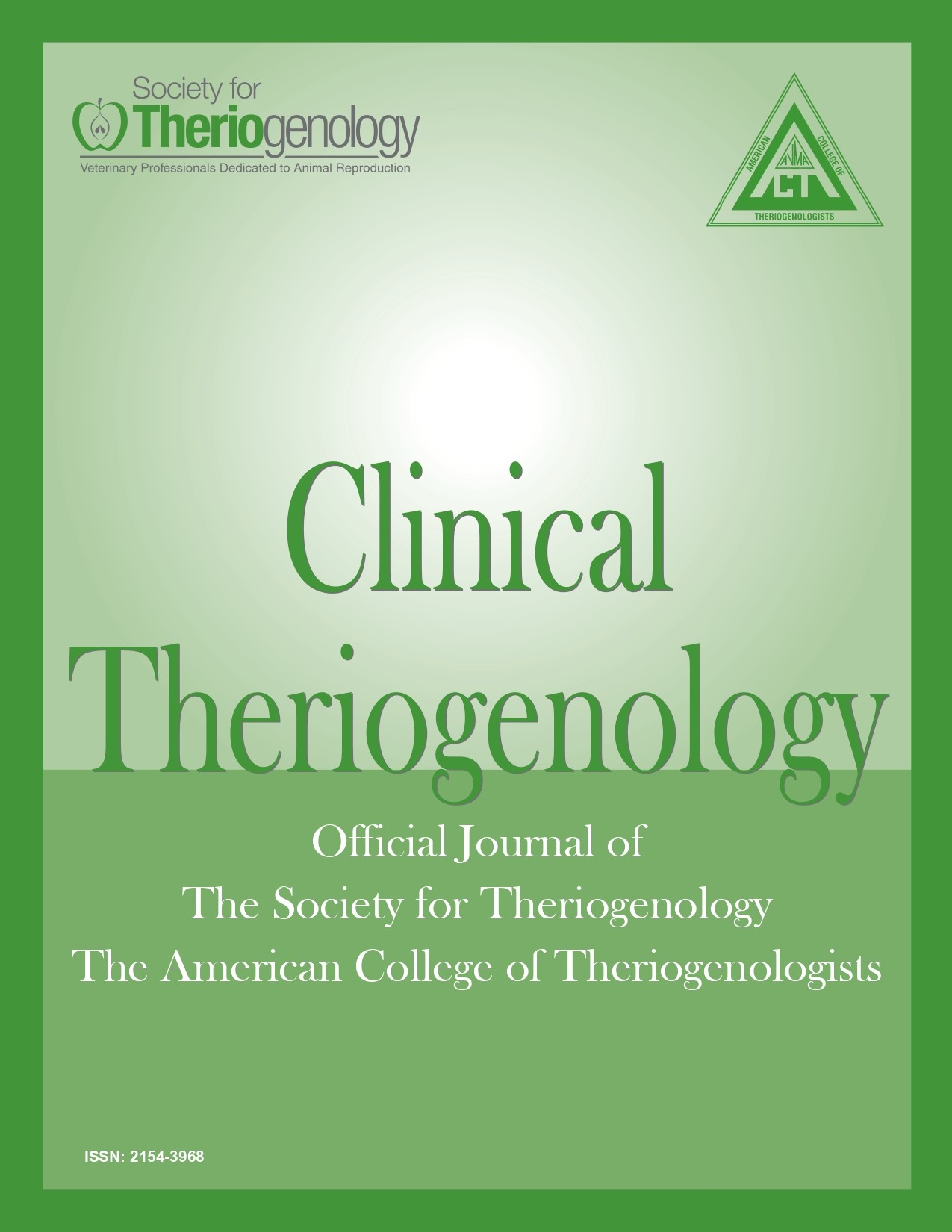Hemoperitoneum secondary to bilateral ovarian enlargement due to undiagnosed male cotwin pregnancy in a mare
Abstract
A 17-year, Quarter Horse mare, was presented for colic symptoms that began the day prior to presentation; patient had no breeding history. Severe bilateral ovarian enlargement precluded transrectal palpation of the gastrointestinal tract and much of the uterus. Transrectal ultrasonography revealed severely enlarged ovaries with multiple, large, ovarian follicles, and structures with an echotexture consistent with hemorrhagic anovulatory follicles, corpora hemorrhagica, and hematoma formation. Transcutaneous abdominal ultrasonography revealed a large volume of peritoneal fluid. Abdominocentesis was performed that identified fluid consistent with frank blood (packed cell volume of 40% consistent with intraabdominal hemorrhage). Initial differential diagnoses included bilateral granulosa-theca cell tumors, other ovarian neoplasia, or ruptured ovarian corpora hemorrhagicum/hematoma resulting in hemoperitoneum. Repeat abdominal ultrasonography revealed a viable pregnancy (~ 70 days). Additional diagnostics obtained 5 days after admission had severely elevated serum testosterone (517.8 pg/ml), elevated inhibin B (160.7 pg/ml), and normal antiMüllerian hormone (0.12 ng/ml) concentrations. After misoprostal and dinoprost tromethamine treatment, manual termination was performed that resulted in the removal of 2 male cotwins. Ovarian size markedly reduced soon after pregnancy termination and serum hormonal concentrations decreased 1 week later to concentrations approaching the reference range for a mare in the first trimester of pregnancy.
Downloads
References
2. Pauwels FE, Wigley SJ, Munday JS, et al: Bilateral ovarian adenocarcinoma in a mare causing haemoperitoneum and colic. N Z Vet J 2012;60:198-202. doi: 10.1080/00480169.2011.647607
3. Conwell RC, Hillyer MH, Mair TS, et al: Haemoperitoneum in horses: a retrospective review of 54 cases. Vet Rec 2010;167:514-528. doi: 10.1136/vr.c4569
4. Dechant JE, Nieto JE, Le Jeune SS: Hemoperitoneum in horses: 67 cases (1989-2004). J Am Vet Med Assoc 2006;229:253-258. doi: 10.2460/javma.229.2.253
5. Murase H, Endo Y, Tsuchiya T, et al: Ultrasonographic evaluation of equine fetal growth throughout gestation in normal mares using a convex transducer. J Med Vet Sci 2014;76:947-953. doi: 10.1292/jvms.13-0259
6. Scott C, Christensen B, Pritchard W, et al: Hemoperitoneum in a mare following rupture of a granulosa-theca cell tumor. Clinical Theriogenology 2015;7:425-429.
7. Worsman FCF, Barakzai SZ, Rubio-Martinez LM, et al: Treatment of haemoperitoneum secondary to ruptured granulosa theca cell tumors in two mares. Equine Vet Edu 2020;32:71-77. doi: 10.1111/eve.12929
8. Squires EL, Ginther OJ: Follicular and luteal development in pregnant Mares. J Reprod Fertil 1975;23:429-433
9. Ginther OJ: Reproductive Biology of the Mare, Basic and Applied Aspects. 2nd edition, Cross Plains; Equiservices Publishing: 1992. p. 237-240.
10. Daels PF, Chang GC, Hansen B, et al: Testosterone secretion during early pregnancy in mares. Theriogenology 1996;45:1211-1219. doi: 10.1016/0093-691X(96)00076-3
11. Tennent-Brown BS: Lactate production and measurement in critically ill horses. Compend Contin Educ Vet 2011;33:E5.
12. Gee EK, Dicken M, Archer RM, et al: Granulosa theca cell tumour in a pregnant mare: concentrations of inhibin and testosterone in serum before and after surgery. N Z Vet J 2011;60:160-163. doi: 10.1080/00480169.2011.645776

This work is licensed under a Creative Commons Attribution-NonCommercial 4.0 International License.
Authors retain copyright of their work, with first publication rights granted to Clinical Theriogenology. Read more about copyright and licensing here.





